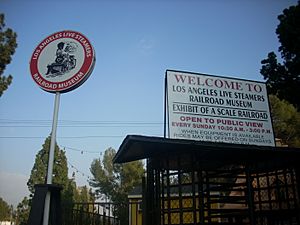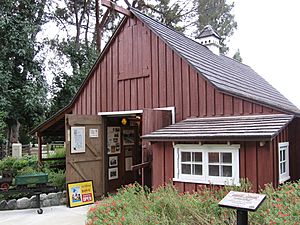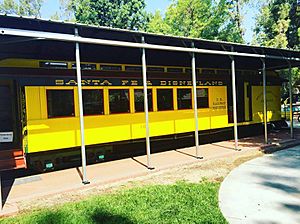Los Angeles Live Steamers Railroad Museum facts for kids
The Los Angeles Live Steamers Railroad Museum (LALSRM) is a special place in Griffith Park in Los Angeles, California. It's a non-profit group started in 1956 by people who loved "live steam" trains. Their goal is to teach everyone about the history of railroads. They also want to share how cool it is to build and run tiny, working model trains.
When the museum first opened, all the model trains used real steam, just like old-fashioned trains. That's why they are called "Live Steamers"! Over time, they added models that run on gasoline, electricity, and even battery power. The museum has a miniature railway with tracks that are 7.5 inches wide. You can even ride on these tiny trains!
The museum also has smaller tracks for members to use. These include 4.75-inch, 3.5-inch, and even elevated tracks. On the third Sunday of each month, you can see a real 19th-century steam engine working. The museum hosts two big events each year for train fans. These are the Spring Meet in May and the Fall Meet in October. They also hold fun events for holidays like Halloween and raise money for charities.
You can also find exhibits about Walt Disney at the museum. He loved trains! There's even a full-size barn that used to be in his backyard. This barn was part of his own miniature railway called the Carolwood Pacific Railroad. A separate group, the Carolwood Foundation, helps run the Disney exhibit. They have volunteers who can tell you all about it.
Contents
History of the Los Angeles Live Steamers
How the Museum Started
In 1956, many people in Los Angeles enjoyed building and running live steam models. They decided to form a club. For a while, they looked for a good place to build their tracks. Then, Charley Atkins, who worked for the Los Angeles Department of Recreation and Parks, became interested. He was looking for something fun to add near the Travel Town Museum.
By October 1956, everyone agreed on a spot. It was an old floodplain, which is flat land near a river. They leveled the ground to get it ready for the tracks.
Building the Tracks and Stations
Starting in 1957, the group began to build. They put in special turntables for the model trains. Then, they laid two big oval tracks. In the early days, there was no fence around the museum. People could walk around and ask engineers for rides!
By 1960, the museum was very popular. They had to build a formal station for riders to wait in line. They also added a fence around the area. The first loading area was called Old Sherwood Station. Later, Sutchville Station was built in 1965 for public rides on the 7.5-inch tracks.
Growing Bigger and Better
By 1965, the railway had many more tracks and even some short bridges. Around this time, Walt Disney, who was a founding member, gave the museum tracks from his own backyard railway. These tracks became the Disney Loop. In 1968, a big mudslide happened, but the area was cleaned up. This led to the creation of the Mountain Division tracks.
The railroad grew a lot in the 1980s. They built a 200-foot long trestle (a type of bridge) and added three tunnels and four more bridges. A very large bridge, the O'Brien-Moore Bridge, was put in place in 1983. In the 1990s, they changed the tracks from aluminum to stronger steel because so many people were riding the trains. Public rides also moved to a new spot called New Sherwood Station. A new G-scale layout, which is a very large model train size, was added nearby for members.
Recent Improvements and Anniversaries
In the early 2000s, the museum made safety better. They started using straddle-type bench cars for riders instead of open cars. In 2002, members built the Smith Valley line, which is another route. From 2006 to 2007, they updated the Webb Yard and Sutchville Station areas. The museum celebrated its 50th anniversary in 2007.
From 2010 to 2012, a new station building was built at New Sherwood Station. It has a ticket booth and restrooms that are easy for everyone to use. In 2014, part of the railway was closed for tunnel work. In 2016, the museum celebrated its 60th anniversary. They also added a new 1-gauge elevated live steam layout.
What You Can See and Do at LALSRM
Train Tracks and Routes
The museum has more than 1.5 miles of 7.5-inch gauge track! This means there are many different routes for the trains to take. Since 2007, public rides mostly happen on the High Line and the Mountain Division tracks. New Sherwood Station is where the public gets on the trains. Sutchville Station and Old Sherwood Station are used by members and for special events.
The layout has many yards, sidings (short tracks for parking trains), turntables, and other special tracks. The museum also has places to load, fix, and store members' trains.
Historic Train Cars
Over the years, the museum has brought in several real, full-size train cars. They have fixed them up to use as offices and meeting rooms. You can see three cabooses (the last car on a freight train) from different old railroads. There are also two fancy passenger cars that used to run on the "City of Los Angeles" train.
Smaller Train Layouts
The museum also has tracks for 4.75-inch and 3.5-inch gauge trains. These tracks are on the ground. There are two loops, three yards, a turntable, and a roundhouse for these smaller trains.
Locomotives (Engines)
Many members have their own model trains. The museum also has several locomotives that qualified members can use for public rides. They have four diesel engines that run on gasoline or batteries. They also have a steam engine built in 2008 that runs on oil.
Walt Disney's Carolwood Barn
Walt Disney's Carolwood Barn is a special museum located right inside the Los Angeles Live Steamers complex. It opened in 1999. This barn was actually Walt Disney's workshop in his own backyard! Walt Disney, who helped start The Walt Disney Company, loved trains very much. He was a founding member of LALSRM, so it was a perfect place for his barn. The barn was moved from his home in Holmby Hills to LALSRM in 1999.
Inside the barn, you'll find many items and memories related to Walt Disney and his love for steam trains. When the barn is open, volunteers from the Carolwood Foundation are there to answer questions. They can give you tours and tell you all about Walt Disney's close connection to trains.
Next to the barn, you can see a "combine car" from the original Retlaw I passenger train of the Disneyland Railroad. There's also a miniature train station that belonged to Disney animator Ollie Johnston. After they are fixed up, a train engine and two cars from the old Mine Train Through Nature's Wonderland ride at Disneyland will also be displayed here.
You can visit Walt Disney's Carolwood Barn for free on the third Sunday of each month. It's open from 11:00 a.m. to 3:00 p.m. This is the same time the museum shows off its stationary steam plant. There's even a separate entrance for the barn on the west side of the museum. Because it's free, some people call it "the only free Disney attraction in the world"!
See also
- Pacific Coast Railroad
- Rail transport in Walt Disney Parks and Resorts




